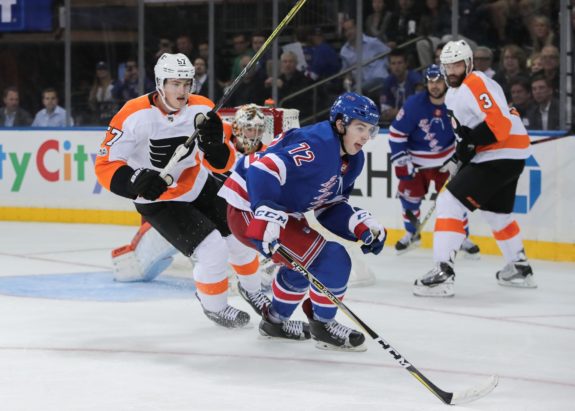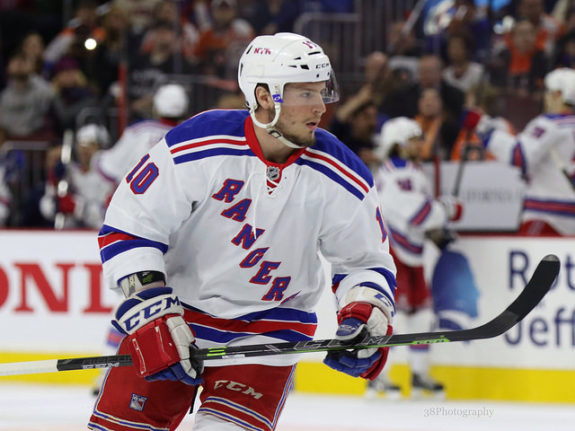There’s no doubt anymore that the theme of the New York Rangers’ rebuild is patience. The club is determined not to force-feed the NHL to its gaggle of young prospects, with many of them set to play in the minors or European leagues in 2018-19.
The measured approach is one that team management believes will pay dividends in the not-too-distant future. That doesn’t mean, however, that young potential cornerstones that are ready for a shot at the NHL should be held back or blocked.
To that end, there’s no reason that rising centers Filip Chytil and Lias Andersson shouldn’t begin this season wearing Blueshirts, likely holding down the middle on the third and fourth lines, respectively.
Both have been impressive in training camp, showing off the speed, elusiveness, scoring touch and hockey sense that led to them being drafted in the first round in 2017, with the expectation that they would grow into core players on Broadway. Barring a major downturn in their play over the remainder of the preseason, that process should ramp up starting opening night Oct. 4 at Madison Square Garden against the Nashville Predators.

The front office appeared to have miscalculated at the outset of last season, when it hoped that Chytil and Andersson would play their way onto the opening-night roster. Andersson, clearly not ready, didn’t make the team and recorded 14 points in 25 games for Hartford of the AHL before playing seven games in a late-season call-up. Chytil did make the team but lasted just two games, during which it was obvious that he too was overwhelmed and needed a season in the minors.
Chytil & Andersson More Ready in 2018-19
Chytil scored 11 goals with 20 assists in 46 games with Hartford in 2017-18 and was recalled along with Andersson late in the season, playing seven more games and recording his first NHL goal with two assists. He’s looked more confident and in command on the ice throughout the preseason, scoring a pretty goal in a win over the Philadelphia Flyers on Wednesday. Though he just turned 19, the time for the 6-foot-2, 208-pounder, the 21st pick in 2017, is now.
“Chytil obviously showed a lot of spurts, a lot of good moments for him,” coach David Quinn said after that contest. “He’s an explosive player, he’s a threatening player every time he’s got the puck out there. … obviously it’s been duly noted how we feel about him and what a big part of our future he is.”
Chytil appears to see it that way too.
“I played a couple games last year at the end of the season, and I feel great, I feel better, I feel more ready,” Chytil said. “I think after this summer, I feel stronger and faster and more skilled. I think I feel much better.”
Ditto for Andersson, taken seventh overall last year with the pick that came from the Arizona Coyotes in the Derek Stepan trade. The soon-to-be 20-year-old delivered a two-goal performance against the New Jersey Devils in the Rangers’ preseason-opening 4-3 overtime victory last Monday, showcasing the two-way skills that made him so appealing to the organization going into the draft. Andersson camped in front of the net and banged home a power-play rebound in the first period, then tied the game in the third with a steal and impressive breakaway short-handed goal.
The 6-1, 204-pound Andersson plays with more edge than Chytil — a seemingly perfect fit for the style Quinn wants to play — and the opportunity for him to win the fourth-line center spot is there. That would likely lead to time on the penalty kill and power play while preventing him from being forced into big even-strength situations as a rookie.
“I have my confidence this year to do more things with the puck and be the type of player my teammates can trust in all situations,” Andersson said. “I know I’m going to have to work hard to make it, but I think I’m ready. I worked hard over the summer to prepare for this.”
Young Centers Can Fully Kick Off Rangers Rebuild
If Andersson does end up centering the bottom forward unit, the Rangers would have to hope that the situation works out better than it did with J.T. Miller during the 2012-13 and 2013-14 seasons. The natural center broke into the NHL spending time in the middle on the fourth line, but struggled to establish himself as a regular player while the team failed to show much patience with him and demoted him to the minors multiple times.
Fans know the rest — Miller’s development remained uneven for the rest of his six-plus seasons on Broadway, and he never took the next step to an elite level before being dealt to the Tampa Bay Lightning in the Ryan McDonagh trade last season.
The question now will be whether Quinn and the Rangers stick with their new mandate: developing young players for the long haul, giving them responsibility and living with the growing pains. There are sure to be trying moments with Chytil and Andersson this season, should they make the big club.

There seems little reason to send either player back to the minors at this point, though, little left for them to accomplish outside of the NHL level. The Blueshirts do have able veterans in Ryan Spooner and Vladislav Namestnikov who are natural centers and could fill the bottom two slots in the lineup.
If the point is indeed building, however, going with the higher-ceiling Chytil and Andersson in the middle, with Spooner and Namestnikov manning spots on the wing, seems to be the more proactive alignment. Quinn sees Chytil and Andersson as the future of the team. In the case of these two young centers, putting the future off for another season would have the feel of going backward instead of forward.